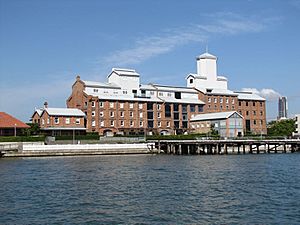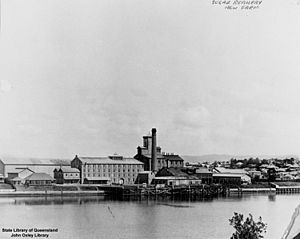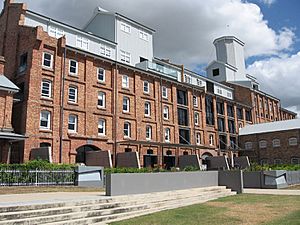CSR Refinery, New Farm facts for kids
Quick facts for kids CSR Refinery |
|
|---|---|

Former CSR Refinery, 2011
|
|
| Location | Lamington Street, New Farm, City of Brisbane, Queensland, Australia |
| Design period | 1870s - 1890s (late 19th century) |
| Built | 1892 - 1893 |
| Built for | Colonial Sugar Refining Company |
| Official name: CSR Refinery (former), Colonial Sugar Refining Company Refinery, New Farm | |
| Type | state heritage (built) |
| Designated | 21 October 1992 |
| Reference no. | 600261 |
| Significant period | 1892-1980s (fabric) 1893-1998 (historical) |
| Significant components | fence/wall - perimeter, boiler room/boiler house, railway, office/administration building, trees/plantings, drainage, workshop, wall/s - retaining, wharf/dock/quay, factory building, laboratory, canteen, store/s / storeroom / storehouse |
| Lua error in Module:Location_map at line 420: attempt to index field 'wikibase' (a nil value). | |
The CSR Refinery is a historic building in New Farm, Brisbane, Australia. It used to be a place where raw sugar was turned into the sugar we use every day. The Colonial Sugar Refining Company built it between 1892 and 1893. This old refinery is now listed on the Queensland Heritage Register, which means it's an important part of Queensland's history.
Contents
A Sweet History
The CSR Refinery in New Farm was built by the Colonial Sugar Refining Company. This company, started in Sydney in 1855, became very important in Australia's sugar industry.
In the 1800s, sugar changed a lot. It went from being a special treat to something everyone used. New technology helped companies like CSR grow. This also helped the sugar industry develop in places like Queensland, where sugar cane grows well.
People tried growing sugar cane in Queensland before it became a separate colony. But it was Captain Louis Hope who really made it work in the 1860s. The government then encouraged more sugar cane farming. Plantations grew in areas like Cleveland and Beenleigh. Soon, new areas along the coast opened up too.
By the 1870s, sugar was being grown in Maryborough and Bundaberg. Small sugar refineries started to open. By 1874, Queensland was even selling sugar to other Australian colonies. In the 1880s, sugar farming moved further north. Important companies like CSR bought large areas of land. They built big mills in North Queensland.
In the early days, large plantations owned by companies grew most of the sugar. Workers often came from the Pacific Islands. But by the 1890s, things changed. The government wanted smaller farms and central mills. This meant that farmers grew the cane, and big companies like CSR focused on turning it into sugar.
The CSR refinery in Brisbane was the fourth one the company built in Australia. They had others in Sydney, Melbourne, and Adelaide. The Brisbane refinery was important because of taxes on sugar products. Building a local refinery helped CSR sell refined sugar in Brisbane.
In 1892, CSR bought land next to the Brisbane River in New Farm. This spot was great because big ships could reach it. It was also close to the city. Local architects helped build the refinery. A big flood in 1893 caused some delays, but it was finished that year.
The new refinery had many buildings. These included the main refinery building, a raw sugar store, a boiler house, and offices. It also had a workshop and a wharf for ships. The machinery often came from Scotland or other CSR refineries. The whole complex was designed by James Muir. He was the manager of the Sydney refinery.
Building the refinery during a tough economic time showed hope for Queensland. It helped the economy grow. The CSR refinery also helped the Bulimba Reach of the river become a major industrial area. A railway line was even built to connect to the refinery. Later, wool stores and a power station were built nearby.
Over the years, the refinery grew and changed. It added new technology to make more sugar. Production more than doubled in the first few years. They bought more land and added new buildings. The raw sugar store was made bigger several times.
During World War II, the refinery almost doubled its output. This was because sugar was an important item. After the war, the refinery continued to grow steadily. They started handling sugar in bulk. A new canteen was built in 1952. By the 1960s, sugar arrived by train or truck, not just by ship. The railway link to the refinery closed in 1989.
In 1993, the refinery celebrated 100 years. They had an open day for the community. Many workers had family who had worked there for generations.
In the 20th century, sugar became one of Queensland's biggest industries. The government protected and regulated it a lot. But later, rules changed, and the New Farm refinery stopped working in 1998. It was then used for storage. The New Farm refinery was one of the last 19th-century sugar refineries left in Australia.
In 2000, CSR sold the site. It was then turned into modern apartments. These apartments are now the main part of the Cutters Landing area. The old workers' recreation room became a gym. Parts of the old wharf and railway line are now public spaces.
What it Looks Like
The CSR site is next to the Brisbane River. It is surrounded by a park, a street, and another house. It's a big part of the river's industrial look. Nearby are the New Farm Power Station and old wool stores.
The main entrance is now from Lamington Street. But the older buildings face the river. The main buildings are in the middle of the site. A wharf is in front of them. Other buildings like the old office and laboratory form a square in front of the main building. Behind the main building is the large raw sugar store. Many buildings have been changed over time. New ones have also been built.
There are many old trees around the site. These include fig trees, poincianas, and palm trees. They are found between buildings and along the river.
Let's look at some of the important buildings:
The Main Building (1893)
This is a long, narrow building right by the river. It's made of strong brick walls. It has four or five floors. The roof is made of corrugated iron.
The brick walls have many arched windows. These windows have metal frames. The building is divided into different sections inside. These sections were used for storing sugar and other refining steps. The back of the building has been changed a lot. This was to add new equipment over the years.
Inside, some floors have been removed. This created tall open spaces. Much of the original machinery has been updated.
The Office (1893)
This two-story brick building was built at the same time as the main building. It also faces the river. It has a double roof with decorative edges.
The front of the building has three windows on each floor. An awning hangs over the ground floor. Inside, the building has been changed to create many offices.
Raw Sugar Store (1893 onwards)
This is the biggest building on the site. It was built in 1893 and has been made much larger many times. Inside, it's one huge open space. Raw sugar was pumped into this building for storage.
It's an unevenly shaped building. You can see where new parts were added because the materials are different. The oldest part has corrugated iron walls and roof. The newest parts have concrete walls.
The Brown Room (1901)
The Brown Room is a small, single-story timber building. It's located near the river. It has verandahs (porches) on three sides. It has a tiled roof. This building was originally a tea room for senior staff.
Inside, it has one large room and two smaller ones. The ceiling is made of ripple iron. The walls are made of wooden boards. This room is now used as a gym for the apartments.
Amenities/Canteen Block (1952)
This building is also by the river, north of the main building. It's a two-story brick building with a tiled roof. It has verandahs on the first floor.
The ground floor had a first aid room and changing rooms. The first floor had a large open space and a canteen. This building was where workers could relax and eat.
The Fence
A white picket fence runs along the river side of the property. It sits on top of a concrete and stone wall. This fence makes the industrial site look a bit like a park. It continues along the next-door property, which was once the manager's house.
Green Spaces
Many old trees are found all over the site. They make the industrial buildings look softer. You can see them well from the other side of the river.
Other features include stone walls and brick drains. You can also see parts of the old railway tracks. These tracks show how sugar used to be moved around the site.
Why it's Important
The former CSR Refinery is important for many reasons:
- Queensland's History: It shows how the sugar industry grew in Queensland. It also shows how the industry changed in the 1890s. The refinery was built because of government trade policies. It also helped the New Farm area become a big industrial and warehouse district.
- Rare Example: This refinery is one of the last 19th-century CSR sites left in Australia. It's a rare example of an old sugar refinery that still shows how it changed over 100 years. It's also one of the last old industrial sites on the Brisbane River that still has its wharf.
- Learning About the Past: Studying the refinery can help us learn more about Queensland's sugar industry. It can also teach us about how old industrial sites worked.
- Typical Features: The site shows what a large sugar refinery looks like. It has many different buildings and structures. These include the main refinery, offices, workshops, and stores. It also has transport links like the wharf and old railway lines. The staff areas, like the Brown Room and Canteen, are also important. The main 1893 building is a great example of a 19th-century industrial building.
- Looks and Feel: The refinery is a big landmark in New Farm. You can see it from the river and other suburbs. Its size and how the buildings are placed make it stand out. Parts like the char tower are very visible. The many trees and the fence along the river add to its unique look.
- Community Connection: The CSR site has a strong connection to past and present workers. Many families have worked there for generations.
- CSR's Story: This refinery was the fourth one built by the Colonial Sugar Refining Company. It shows how important CSR was in the sugar industry in Queensland and Australia for over 100 years.
Images for kids





